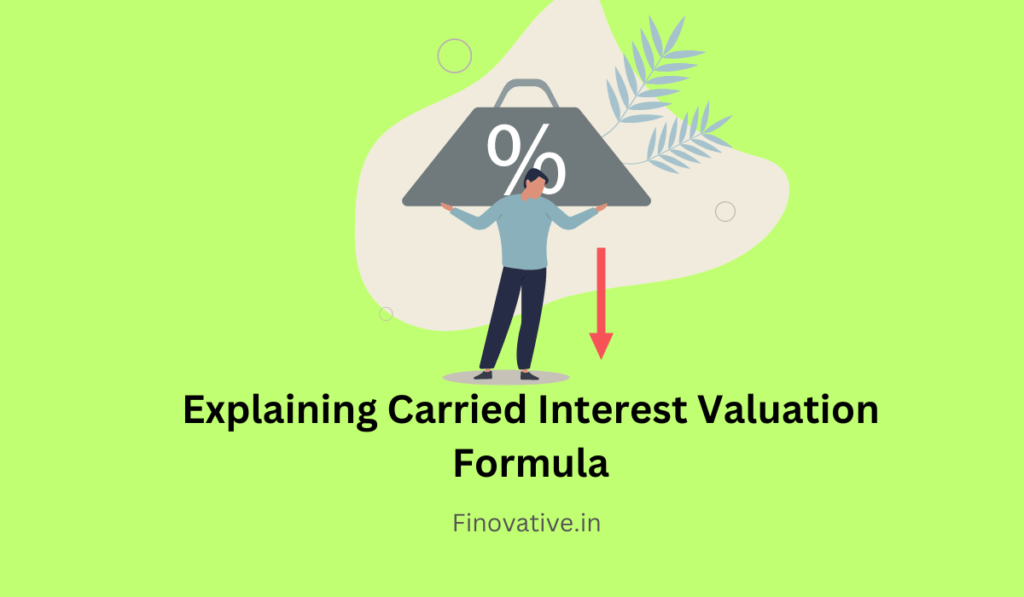Carried interest, often called “carry,” is a crucial element of compensation for investment professionals in private equity, venture capital, and hedge funds. It represents the share of profits fund managers receive as an incentive for successful investments. Understanding how carried interest is calculated and valued is essential for investors and fund managers. In this comprehensive guide, we will explore the held interest valuation formula, its components, and the significance of this calculation in the finance industry.
What is Carried Interest?
Before diving into the valuation formula, let’s briefly revisit what carried interest is and why it matters:
Carried Interest Definition: Carried interest is a portion of the profits earned by an investment fund that is allocated to the fund’s managers, also known as general partners. It serves as a performance-based incentive, aligning the interests of fund managers with those of the investors in the fund.
Purpose of Carried Interest: Carried interest motivates investment professionals to make strategic investment decisions that maximize returns for investors. It is a way to reward managers for their expertise and successful investment strategies.
The Components of the Carried Interest Valuation Formula
The carried interest valuation formula is used to calculate the monetary value of the carried interest that investment managers are entitled to. It involves several components:
1. Fund Profit
The first component of the formula is the total profit generated by the investment fund. This profit is typically calculated as the difference between the fund’s final net asset value (NAV) and its initial NAV. In essence, it represents the financial gains realized by the fund’s investments.
2. Hurdle Rate
The hurdle rate is a predetermined minimum rate of return that the fund must achieve before carried interest is distributed to the investment managers. It serves as a threshold that ensures investors receive a specified level of returns before the managers participate in the profits.
3. Carried Interest Percentage
The carried interest percentage represents the share of profits that investment managers are entitled to. It is usually expressed as a percentage and defined in the fund’s partnership agreement or operating agreement. Common carried interest percentages range from 15% to 30%, depending on the industry and fund terms.
4. High-Water Mark
A high-water mark is a mechanism that prevents investment managers from receiving carried interest on profits that have already been distributed to investors in previous periods. It ensures that managers only participate in profits generated above the highest historical NAV of the fund.
5. Fund Expenses
Fund expenses, such as management fees and operating costs, can impact the net profits available for carried interest calculation. Some expenses may be deducted before calculating carried interest, reducing the overall amount available for distribution.
6. Catch-Up Provision
Some fund structures include a catch-up provision, which allows investment managers to receive a more substantial share of profits until they reach a predetermined target percentage. After reaching this target, profits are divided according to the established carried interest percentage.
Now that we understand the components involved let’s explore the carried interest valuation formula itself.
The Carried Interest Valuation Formula
The carried interest valuation formula calculates the monetary value of the carried interest based on the components mentioned above. The formula is as follows:
Carried Interest Value = (Fund Profit – (Initial NAV + Fund Expenses)) × Carried Interest Percentage
To break down this formula:
- Fund Profit: This is the total profit generated by the investment fund, as discussed earlier.
- Initial NAV: The initial net asset value of the fund, which represents the fund’s value at the beginning of a specific period.
- Fund Expenses: These expenses, including management fees and operating costs, are subtracted from the fund profit to arrive at the net profit available for distribution.
- Carried Interest Percentage: The carried interest percentage, expressed as a decimal, is applied to the net profit to calculate the carried interest value.
It’s important to note that the high-water mark and catch-up provisions can add complexity to the calculation, particularly in funds with these features. These provisions can affect when and how carried interest is allocated.
An Example Carried Interest Valuation
Let’s illustrate the carried interest valuation formula with a hypothetical example:
- Fund Profit: The investment fund generates a total profit of $10 million during a specific period.
- Initial NAV: At the beginning of the period, the fund had an initial net asset value of $80 million.
- Fund Expenses: The total fund expenses for the period amount to $2 million.
- Carried Interest Percentage: The carried interest percentage, as defined in the fund’s agreement, is 20%, or 0.20 as a decimal.
Now, let’s calculate the carried interest value:
Carried Interest Value = ($10 million – ($80 million + $2 million)) × 0.20
Carried Interest Value = ($10 million – $82 million) × 0.20
Carried Interest Value = (-$72 million) × 0.20
Carried Interest Value = -$14.4 million
In this example, the carried interest value is -$14.4 million. This means that, based on the fund’s performance, the investment managers are not entitled to any carried interest, as the fund did not achieve a profit above the hurdle rate and fund expenses exceeded the available profit.
Significance of Carried Interest Valuation
Carried interest valuation is significant for several reasons, both for investment professionals and investors:
1. Fair Compensation
For investment managers, the valuation formula ensures that their compensation is directly tied to the fund’s performance. They are rewarded when the fund generates profits above the hurdle rate, aligning their interests with those of the investors.
2. Investor Protection
The hurdle rate and high-water mark mechanisms in the carried interest calculation protect investors. Investors are entitled to a minimum return before investment managers participate in the profits. The high-water mark prevents managers from benefiting from previously distributed profits if subsequent performance falters.
3. Motivation and Incentives
Carried interest serves as a powerful motivational tool for investment professionals. It encourages them to make prudent investment decisions and actively manage the fund to achieve superior returns.
4. Transparency
Understanding the carried interest valuation formula promotes transparency in the compensation structure. Investors can evaluate the fairness of the compensation arrangement and assess the potential impact on their returns.
Legal and Regulatory Considerations
It’s important to note that carried interest has been a subject of debate and regulatory scrutiny in some regions. In the United States, for example, there have been discussions about potentially changing the tax treatment of carried interest to ensure that investment managers pay taxes at ordinary income rates rather than capital gains rates. Such changes can have significant implications for the after-tax returns of investment managers and are subject to legislative changes.
Investment professionals and fund managers must stay informed about the legal and regulatory landscape governing carried interest in their respective jurisdictions, as it can impact the structure and taxation of carried interest distributions.
Conclusion
Carried interest valuation is a fundamental aspect of compensation in the finance industry, particularly in private equity, venture capital, and hedge funds. The formula used to calculate carried interest considers various components, including fund profit, hurdle rate, carried interest percentage, fund expenses, high-water mark, and catch-up provisions.
Understanding how carried interest is valued is essential for both investment professionals and investors. It ensures that compensation is tied to fund performance, aligns the interests of managers and investors, and promotes transparency in the compensation structure. Furthermore, carried interest valuation is subject to legal and regulatory considerations that can impact taxation and the overall structure of carried interest distributions. Staying informed about these developments is crucial for all parties involved in investment funds.


